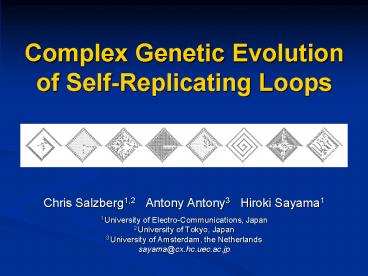Complex Genetic Evolution of Self-Replicating Loops - PowerPoint PPT Presentation
1 / 22
Title:
Complex Genetic Evolution of Self-Replicating Loops
Description:
We re-examined the evolutionary dynamics of self-replicating loops on CA, by ... by a quadratic coefficient of a parabola fitted to the population growth curve ... – PowerPoint PPT presentation
Number of Views:67
Avg rating:3.0/5.0
Title: Complex Genetic Evolution of Self-Replicating Loops
1
Complex Genetic Evolution of Self-Replicating
Loops
- Chris Salzberg1,2 Antony Antony3 Hiroki
Sayama1 - 1 University of Electro-Communications, Japan
- 2 University of Tokyo, Japan
- 3 University of Amsterdam, the Netherlands
- sayama_at_cx.hc.uec.ac.jp
2
Summary
- We re-examined the evolutionary dynamics of
self-replicating loops on CA, by using new tools
for complete genetic identification and genealogy
tracing - We found in the loop populations
- Diversities in macro-scale morphologies and
mutational biases - Genetic adaptation
- Genetic diversification and continuing exploration
3
Background CA-based Alife
- Universal constructor (Von Neumann 1966 Codd
1968 Takahashi et al. 1990 Pesavento 1995) - Self-replicating loops (Langton 1984 Byl 1989
Reggia et al. 1993) - Self-inspecting loops/worms (Ibanez et al. 1995
Morita et al. 1995, 1996) - Self-replicating loops with additional
capabilities of construction/computation
(Tempesti 1995 Perrier et al. 1996 Chou et al.
1998) - Spontaneous emergence and evolution of
self-replicators (Lohn et al. 1995 Chou et al.
1997 Sayama 1998, 2000, 2003 Salzberg et al.
2003, 2004 Suzuki et al. 2003, 2004)
4
Supposedly Limited Evolutionary Dynamics in CA
- McMullin (2000)
- SR loop does not embody anything like a
general constructive automaton and therefore has
little or no evolutionary potential. - Suzuki et al. (2003)
- Though there are many other variations of CA
models for self-replication, their evolvability
does not differ very much.
5
Question
- Did we truly understand what was going on in this
seemingly simple dynamics of our CA-based
evolutionary systems? - We didnt know we didnt, until we have developed
the formal framework and the sophisticated tools
for detailed analysis and visualization for those
systems.
6
Subject Evoloop
- An evolvable SR loop by Sayama (1999) constructed
on nine-state five-neighbor fully deterministic
CA - Robust state-transition rules give rise to
evolutionary behavior - Mutation/selection mechanisms are totally emergent
7
New Tools for Detailed Analysis
- At every birth, the newborn loops genotype
phenotype and its genealogical information is
detected and recorded in an event-driven fashion - Each genotype-phenotype pair is indexed in the
Species Database
8
Observation (1)Diversities in Macro-Scale
Morphologies and Mutational Biases
9
Huge Genetic State-Space
- Permutation of genes (G, T) and core states (C)
under constraints estimates the number of viable
genotypes to be
2n-2 n-2
Size n of species Size n of species Size n of species
4 15 9 11,440 14 9,657,700
5 56 10 43,758 15 37,442,160
6 210 11 167,960 16 145,422,675
7 792 12 646,646 17 565,722,720
8 3,003 13 2,496,144 18 2,203,961,430
10
Diversity in Growth Patterns (size-4)
11
Diversity in Growth Patterns (size-6)
12
Diversity in Mutational Biases (size-6)
(new result not included in paper)
13
Observation (2)Genetic Adaptation
14
Two Measures of (Possible) Fitness
- Survival rate (sustainability in competition)
- Characterized by an average of relative
population ratios of a species after a given
period of time in competition with another
species - Colony density index (growth speed)
- Characterized by a quadratic coefficient of a
parabola fitted to the population growth curve of
each species in an infinite domain
15
Variety and Correlation (size-4)
16
Evolution in vivo(starting from size-8)
17
Evolution Optimizes Fitness
Evolutionary transition actually observed in the
previous slide
18
Observation (3)Genetic Diversification and
Continuing Exploration
19
Non-Mutable Subsequences
GGGGCGC GCCTCCTG G
- Certain subsequences are found non-mutable
- GCTCTG
- A long non-mutable sub-sequence injected to
ancestor causes a relatively large lower bound of
viable sizes upon its descendants, a reduced
size-based selection pressure, and a highly
biased mutational tendency to larger species - Such GMO loops show long-lasting evolutionary
exploration processes
20
control
with long non-mutable subsequences
with subsequences hostile environment
(new result not included in paper)
21
Conclusions
- Huge diversity, non-trivial genetic adaptation
and diversification unveiled in the evoloop
system - Hierarchical emergence demonstrated, where
macro-scale evolutionary changes of populations
arises from micro-scale interactions between
elements much smaller than individual
replicators, traversing multiple scales
22
References Acks
- Salzberg, C. (2003) Emergent Evolutionary
Dynamics of Self-Reproducing Cellular Automata.
M.Sc. Thesis. Universiteit van Amsterdam, the
Netherlands. - Salzberg, C., Antony, A. Sayama, H. Visualizing
evolutionary dynamics of self-replicators A
graph-based approach. Artificial Life, in press. - Sayama, H. The SDSR loop / Evoloop Homepage.
http//complex.hc.uec.ac.jp/sayama/sdsr/ - Antony, A. Salzberg, C. The Artis Project
Homepage. http//artis.phenome.org/ - This work is supported in part by the Hayao
Nakayama Foundation for Science, Technology
Culture, and the International Information
Science Foundation, Japan.






























